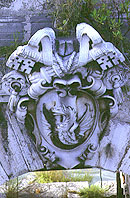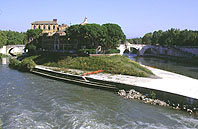Forum Boarium - Ghetto - Tiber Island
Tiber Island
(Isola Tiberina). The bridges spanning the divided river date from ancient Roman times.
| Tiber Island History
|
Isola Tiberina (Map G 7-8)
Pons Fabricius
(Ponte Fabricio) (62 BC). A beautiful stone bridge joining the island to the center of Ancient Rome. Formerly it had a bronze rail (the present marble parapet was added in 1679 under Pope Innocent XI Odescalchi). The oldest continuously used bridge in Rome.
Pons Cestius
(Ponte Cestio) (46 BC). The other superb bridge links the island to Trastevere on the west. On the pillars there used to be statues of Gration and Valens who rebuilt the bridge in 369 AD.
This, the Tiber River's only remaining island (till the Middle Ages there was at least one other) is boat-shaped and was clad in travertine in ancient times to disguise it as a ship. Its marble stern downstream is still visible today.
The picturesque central square is dominated by a hospital that enjoys a good medical reputation and a superb view of the riverbanks.
Fatebenefratelli Hospital
(Ospedale Fatebenefratelli). This attractive medical institution was created in 1548 for the religious order whose name appropriately means "Do good brothers!" Known for its emergency ward.
San Giovanni Calibita: Annexed to the hospital is this lovely late Baroque church with the best painting on the island, Matia Preti's "Flagellation of Christ".
Caetani Tower: this tower was built before the year 1000 by the Pierleone family who were of Jewish origin but produced Anacletus II, a powerful 12C anti-pope. It was the strong point of the adjacent:
Pierleone-Caetani Castle: another Medieval tower construction which served in 1087 as a refuge for the great champion of the Popes against the German emperors, the Countess Matilda of Tuscany, and for several fugitive popes who fled from their enemies to be protected here by the impregnable Pierleoni family, later followed by the equally powerful Caetani.
St. Bartolomeo all’Isola
Exterior 1624. The Baroque facade masks a church built in the 10C by the Holy Roman Emperor "the wonder of the world", Otto III.
Fancying himself as a fitting successor to the Caesars, Otto III personally installed two Popes, Gregory V, the first German pontiff, and Silvester II, the first French one.
He built this church, which he could see from his palace on the Aventine Hill, on the ruins of the 3C BC Temple of Aesculapius.
The altar step (beautifully carved in the 12C) shows that there used to be an ancient spring of sacred medicinal water here.
Ponte Rotto

Originally Pons Aemilius 2C BC.
Rebuilt by Pope Gregory XIII in 1575 after it collapsed twice, it self-destructed again a few years later.
Its death knell came when in the last century it was accidentally blown up during construction of the present day metal bridge, Ponte Palatino.
 293 BC. The island entered medical history during a plague when the Roman Senate sent envoys to consult the medical god Aesculapius in Greece. They returned with a miracle-dispensing snake, which slipped overboard at this spot in the river. The temple was built where the snake landed, serving as a hospital for many centuries.
293 BC. The island entered medical history during a plague when the Roman Senate sent envoys to consult the medical god Aesculapius in Greece. They returned with a miracle-dispensing snake, which slipped overboard at this spot in the river. The temple was built where the snake landed, serving as a hospital for many centuries.